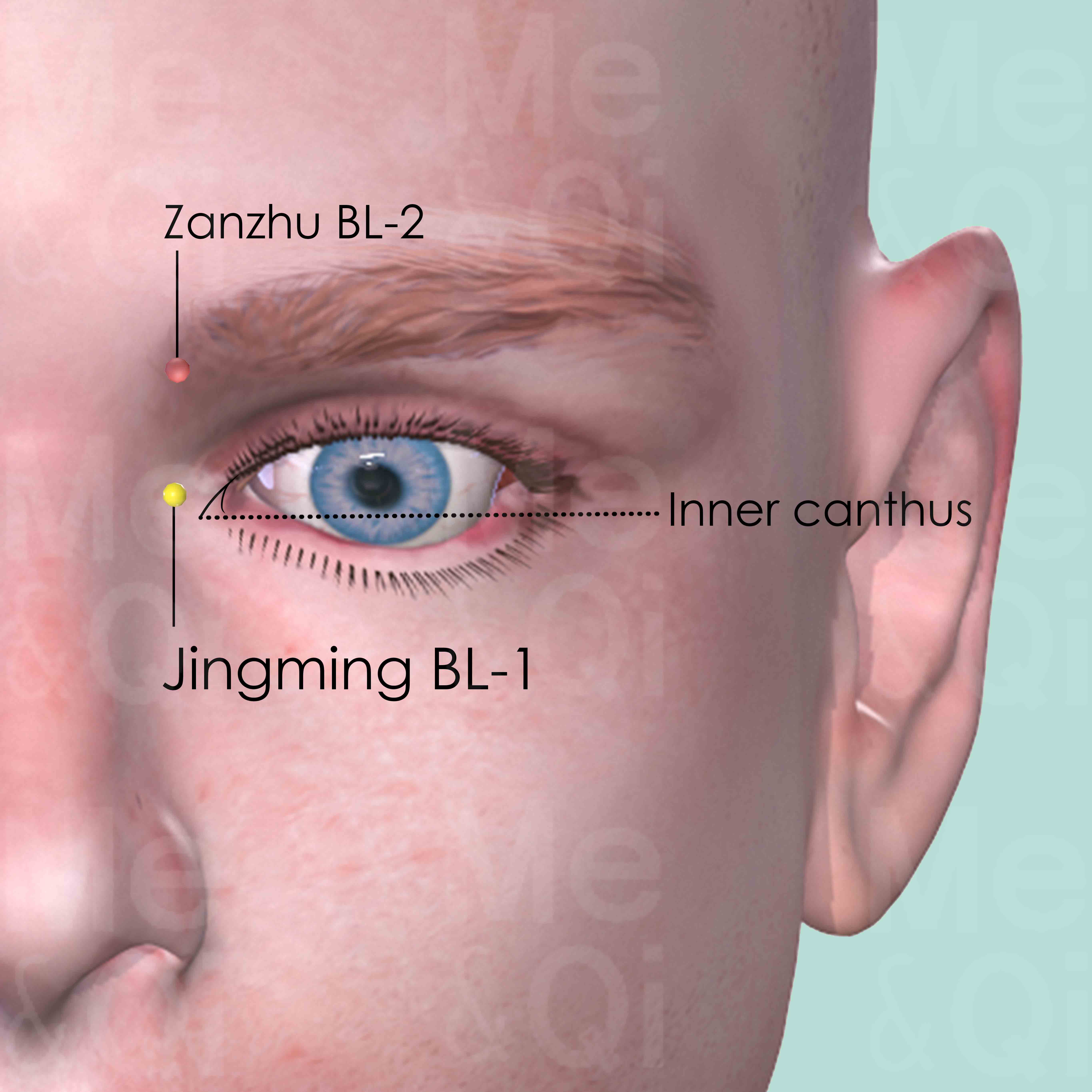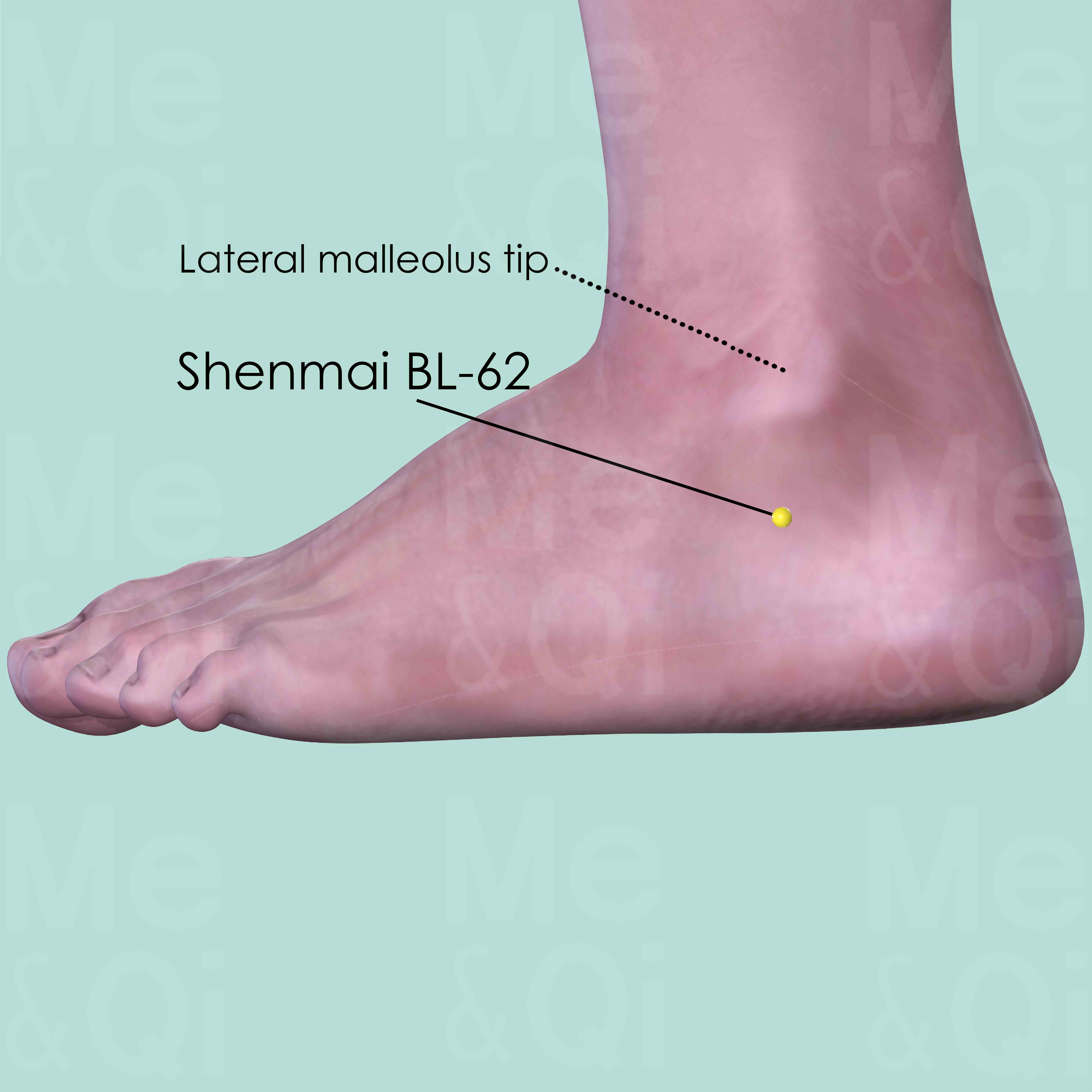Hypersomniaaccording to TCM
Symptom family: Fatigue and Sleepiness
Root Causes of Hypersomnia in TCM
Explore below more details about what might cause Hypersomnia according to TCM.
- By Syndrome
- By Organ
- Yang Deficiency
- Cold
- Phlegm
- Mind Disturbance
- Qi Deficiency
- Blood Deficiency
- Wind
- View More Causes
- Kidney
- Heart
Yang Deficiency
Yang deficiency in TCM refers to a state where the body's Yang energy, which is responsible for warmth, activity, and function, is weakened or diminished. This pattern of disharmony often arises from chronic illness, aging, or inherent constitutional weakness. Symptoms of Yang deficiency are typically associated with cold and sluggishness, such as a feeling of coldness, cold extremities, pale complexion, low energy or fatigue, and a desire for warmth. Digestive issues like poor appetite, loose stools, and water retention can also be indicative of Yang deficiency.... see more
Yang Deficiency Patterns That Can Lead to Hypersomnia
Common Symptoms: Cold Extremities Chills Diarrhea Absence Of Thirst Desire To Lie In Fetal Position Low Energy Frequent Pale Urination Low Grade Fever
| Pattern Name | Relevant Symptoms | Relevant Formulas |
|---|---|---|
| Lesser Yin Cold Transformation | Desire to sleep, Chills, Diarrhea, Absence of thirst, Desire to lie in fetal position, Low energy, Hypersomnia, Cold extremities, Frequent pale urination... see more | Si Ni Tang |
| Wind-Cold invading with Yang Deficiency | Desire to sleep, Low grade fever, Severe chills, Exhaustion, Hypersomnia, Cold extremities, Lumbar pain, Lower back pain, Lower back coldness, General cold feeling, Lack of sweating, Headaches, Weak voice... see more | Ma Huang Xi Xin Fu Zi Tang | Zai Zao San |
Cold
In TCM "Cold" as a pattern of disharmony refers to a specific type of imbalance within the body's systems, often linked to a deficiency or weakness. It's not about feeling physically cold or having a common cold, but rather a metaphorical description of certain symptoms and underlying conditions. When a TCM practitioner says someone suffers from "Cold," it usually implies that the body's Yang energy, which is warm and active, is insufficient or overpowered by Yin energy, which is cool and passive. Symptoms of Cold in TCM can include a general feeling of coldness, cold limbs, pale complexion, low energy, slow metabolism, and a preference for warmth. ... see more
Cold Patterns That Can Lead to Hypersomnia
Common Symptoms: Cold Extremities Chills Diarrhea Absence Of Thirst Desire To Lie In Fetal Position Low Energy Frequent Pale Urination Low Grade Fever
| Pattern Name | Relevant Symptoms | Relevant Formulas |
|---|---|---|
| Lesser Yin Cold Transformation | Desire to sleep, Chills, Diarrhea, Absence of thirst, Desire to lie in fetal position, Low energy, Hypersomnia, Cold extremities, Frequent pale urination... see more | Si Ni Tang |
| Wind-Cold invading with Yang Deficiency | Desire to sleep, Low grade fever, Severe chills, Exhaustion, Hypersomnia, Cold extremities, Lumbar pain, Lower back pain, Lower back coldness, General cold feeling, Lack of sweating, Headaches, Weak voice... see more | Ma Huang Xi Xin Fu Zi Tang | Zai Zao San |
Phlegm
In TCM "Phlegm" as a pattern of disharmony is a complex concept that extends beyond the physical manifestation of mucus. It represents a pathological factor that can disrupt the flow of Qi (vital energy) and blood, leading to various health issues. Phlegm in TCM is seen as a sticky, turbid substance arising from the body's inability to metabolize fluids properly, often due to a dysfunction of the spleen. It's not only associated with respiratory problems like cough and congestion but also with systemic issues. Symptoms can include a feeling of heaviness, mental cloudiness, dizziness, and in some cases, the formation of lumps or masses. Phlegm can even be "invisible," contributing to emotional disturbances like depression or stress. ... see more
Phlegm Patterns That Can Lead to Hypersomnia
| Pattern Name | Relevant Symptoms | Relevant Formulas |
|---|---|---|
| Phlegm Misting the Heart | Lethargic and withdrawn state, Confusion, Loss of consciousness, Hypersomnia, Incoherent or confused speech, Slurred speech, Aphasia, Noisy breathing, Vomit... see more | Wen Dan Tang | Di Tan Tang | Gun Tan Wan | Su He Xiang Wan |
Mind Disturbance
In TCM "Shen" refers to the mind or spirit, and a Shen disturbance is a pattern of disharmony that affects the mental and emotional state. This concept reflects the TCM belief in the deep interconnectedness of mind and body. Symptoms of Shen disturbance can vary widely but often include anxiety, insomnia, restlessness, confusion, or in severe cases, hallucinations or delirium. These symptoms indicate an imbalance in the body's energies affecting the heart, which in TCM is not only the center of blood circulation but also the seat of the mind and consciousness. The root of Shen disturbance can be traced to various factors, including emotional stress, physical illness, or an imbalance in fundamental substances like Qi, Yin, or Yang.... see more
Mind Disturbance Patterns That Can Lead to Hypersomnia
| Pattern Name | Relevant Symptoms | Relevant Formulas |
|---|---|---|
| Phlegm Misting the Heart | Lethargic and withdrawn state, Confusion, Loss of consciousness, Hypersomnia, Incoherent or confused speech, Slurred speech, Aphasia, Noisy breathing, Vomit... see more | Wen Dan Tang | Di Tan Tang | Gun Tan Wan | Su He Xiang Wan |
Qi Deficiency
Qi Deficiency in TCM is like running low on battery power. Qi is the vital energy that powers every function in your body. When there's a Qi Deficiency, it means your body doesn't have enough of this essential energy. This can make you feel tired all the time, weak, or even cause shortness of breath. It's similar to how you feel when you haven't had enough sleep or nutritious food. Your body just doesn't have the energy it needs to perform at its best. Unlike modern medicine, which often focuses on specific physical causes for fatigue and weakness, TCM views Qi Deficiency as an overall energy depletion that affects your entire well-being, and it seeks to replenish and balance this vital energy.... see more
Qi Deficiency Patterns That Can Lead to Hypersomnia
| Pattern Name | Relevant Symptoms | Relevant Formulas |
|---|---|---|
| Qi and Blood Deficiency | Lethargic and withdrawn state, General weakness, Generalized fatigue, Weak voice, Pale face, Shortness of breath, Palpitations, Dizziness, Poor memory, Insomnia, Reluctance to speak, Lack of appetite, Limb numbness, Skin numbness... see more | Sheng Yu Tang |
Blood Deficiency
Blood Deficiency in TCM is like when your body's tank runs low on the vital energy that blood provides. It's not exactly the same as anemia in modern medicine, which is about having too few red blood cells. Instead, Blood Deficiency in TCM is about your body not having enough of the life-giving qualities that blood brings, like nourishment and moisture. This can make you feel tired, look pale, and even feel dizzy or have blurry vision. It's like a garden not getting enough water to stay lush and vibrant. TCM sees this as an imbalance where the body isn't being nourished as it should be, impacting overall health and well-being.... see more
Blood Deficiency Patterns That Can Lead to Hypersomnia
| Pattern Name | Relevant Symptoms | Relevant Formulas |
|---|---|---|
| Qi and Blood Deficiency | Lethargic and withdrawn state, General weakness, Generalized fatigue, Weak voice, Pale face, Shortness of breath, Palpitations, Dizziness, Poor memory, Insomnia, Reluctance to speak, Lack of appetite, Limb numbness, Skin numbness... see more | Sheng Yu Tang |
Wind
In TCM "Wind" is a concept that represents a pattern of disharmony, often characterized by its sudden and unpredictable nature, much like a gusty wind changing direction without warning. This pattern is associated with symptoms that come and go quickly or move around the body, such as itching, tremors, or even certain types of pain. Wind is considered to be a primary cause of illnesses that have these rapidly changing characteristics. In TCM, external Wind often refers to illnesses that start suddenly, like the common cold, believed to be caused by external pathogenic factors like climatic changes. On the other hand, internal Wind can be linked to internal imbalances and can manifest in conditions like dizziness or spasms. ... see more
Wind Patterns That Can Lead to Hypersomnia
| Pattern Name | Relevant Symptoms | Relevant Formulas |
|---|---|---|
| Wind-Cold invading with Yang Deficiency | Desire to sleep, Low grade fever, Severe chills, Exhaustion, Hypersomnia, Cold extremities, Lumbar pain, Lower back pain, Lower back coldness, General cold feeling, Lack of sweating, Headaches, Weak voice... see more | Ma Huang Xi Xin Fu Zi Tang | Zai Zao San |
Kidney
In TCM the Kidneys are regarded as the body's most fundamental reservoir of Essence, known as Jing, which influences growth, reproduction, and aging. They are not just organs for filtering blood, but a holistic system governing vital life forces. When the Kidneys malfunction in TCM, it can manifest as a variety of health issues, such as chronic fatigue, reproductive problems, imbalances in fluid metabolism leading to edema or dryness, lower back pain, and a sense of fear or insecurity.... see more
Kidney Patterns That Can Lead to Hypersomnia
| Pattern Name | Relevant Symptoms | Relevant Formulas |
|---|---|---|
| Lesser Yin Cold Transformation | Desire to sleep, Chills, Diarrhea, Absence of thirst, Desire to lie in fetal position, Low energy, Hypersomnia, Cold extremities, Frequent pale urination... see more | Si Ni Tang |
Heart
In TCM the Heart is considered the "emperor" of all organs, primarily responsible for governing Blood and housing the mind, known as "Shen." It plays a crucial role in maintaining mental-emotional equilibrium and controlling the circulation of Qi and blood throughout the body. When the Heart is imbalanced or malfunctions in TCM, it can lead to a range of issues like heart palpitations, insomnia, dream-disturbed sleep, anxiety, and a flushed complexion. Emotional disturbances such as excessive joy or lack of joy are also seen as signs of Heart disharmony. These symptoms reflect not just physical heart conditions but also the state of one's Shen, indicating the interconnectedness of physical and emotional well-being in TCM.... see more
Heart Patterns That Can Lead to Hypersomnia
| Pattern Name | Relevant Symptoms | Relevant Formulas |
|---|---|---|
| Phlegm Misting the Heart | Lethargic and withdrawn state, Confusion, Loss of consciousness, Hypersomnia, Incoherent or confused speech, Slurred speech, Aphasia, Noisy breathing, Vomit... see more | Wen Dan Tang | Di Tan Tang | Gun Tan Wan | Su He Xiang Wan |
TCM Herbal Formulas for Hypersomnia
Explore below some TCM herbal formulas used to address hypersomnia, organized by cause and by formula type.
- By Cause
- By Formula Type
- Yang Deficiency
- Cold
- Phlegm
- Mind Disturbance
- Qi Deficiency
- Blood Deficiency
- Wind
- View More Causes
- Formulas that clear exterior disorders with interior deficiency
- Formulas that rescue devastated yang
- Formulas that dry dampness and transform phlegm
- Formulas that dispel phlegm
- Formulas that clear heat and transform phlegm
- Formulas that warm and open sensory orifices
- Formulas that tonify blood
Top Formula for Yang Deficiency:
Si Ni Tang
Suitable for Yang Deficiency patterns that may cause hypersomnia, such as Lesser Yin Cold Transformation
Learn moreAll Formulas Recommended for Hypersomnia Caused by Yang Deficiency
| Formula | Patterns Suitable For |
|---|---|
| Si Ni Tang | Lesser Yin Cold Transformation |
| Ma Huang Xi Xin Fu Zi Tang | Wind-Cold invading with Yang Deficiency |
| Zai Zao San | Wind-Cold invading with Yang Deficiency |
Top Formula for Cold:
Si Ni Tang
Suitable for Cold patterns that may cause hypersomnia, such as Lesser Yin Cold Transformation
Learn moreAll Formulas Recommended for Hypersomnia Caused by Cold
| Formula | Patterns Suitable For |
|---|---|
| Si Ni Tang | Lesser Yin Cold Transformation |
| Ma Huang Xi Xin Fu Zi Tang | Wind-Cold invading with Yang Deficiency |
| Zai Zao San | Wind-Cold invading with Yang Deficiency |
Top Formula for Phlegm:
Wen Dan Tang
Suitable for Phlegm patterns that may cause hypersomnia, such as Phlegm Misting the Heart
Learn moreAll Formulas Recommended for Hypersomnia Caused by Phlegm
| Formula | Patterns Suitable For |
|---|---|
| Wen Dan Tang | Phlegm Misting the Heart |
| Di Tan Tang | Phlegm Misting the Heart |
| Gun Tan Wan | Phlegm Misting the Heart |
| Su He Xiang Wan | Phlegm Misting the Heart |
Top Formula for Mind Disturbance:
Wen Dan Tang
Suitable for Mind Disturbance patterns that may cause hypersomnia, such as Phlegm Misting the Heart
Learn moreAll Formulas Recommended for Hypersomnia Caused by Mind Disturbance
| Formula | Patterns Suitable For |
|---|---|
| Wen Dan Tang | Phlegm Misting the Heart |
| Di Tan Tang | Phlegm Misting the Heart |
| Gun Tan Wan | Phlegm Misting the Heart |
| Su He Xiang Wan | Phlegm Misting the Heart |
Top Formula for Qi Deficiency:
Sheng Yu Tang
Suitable for Qi Deficiency patterns that may cause hypersomnia, such as Qi and Blood Deficiency
Learn moreTop Formula for Blood Deficiency:
Sheng Yu Tang
Suitable for Blood Deficiency patterns that may cause hypersomnia, such as Qi and Blood Deficiency
Learn moreTop Formula for Wind:
Ma Huang Xi Xin Fu Zi Tang
Suitable for Wind patterns that may cause hypersomnia, such as Wind-Cold invading with Yang Deficiency
Learn moreAll Formulas Recommended for Hypersomnia Caused by Wind
| Formula | Patterns Suitable For |
|---|---|
| Ma Huang Xi Xin Fu Zi Tang | Wind-Cold invading with Yang Deficiency |
| Zai Zao San | Wind-Cold invading with Yang Deficiency |
Formulas that clear Exterior disorders with Interior deficiency
These formulas are suitable for some hypersomnia-causing patterns like Wind-Cold invading with Yang Deficiency.
One such formula is Ma Huang Xi Xin Fu Zi Tang, with ephedra as a key herb.
Other formulas of this category are listed in the table below.
All "formulas that clear exterior disorders with interior deficiency" recommended for hypersomnia
| Formula | Patterns Suitable For (if applicable) |
|---|---|
| Ma Huang Xi Xin Fu Zi Tang | Wind-Cold invading with Yang Deficiency |
| Zai Zao San | Wind-Cold invading with Yang Deficiency |
Formulas that rescue devastated Yang
These formulas are suitable for some hypersomnia-causing patterns like Lesser Yin Cold Transformation.
One such formula is Si Ni Tang, with prepared aconite as a key herb.
Formulas that dry Dampness and transform Phlegm
These formulas are suitable for some hypersomnia-causing patterns like Phlegm Misting the Heart.
One such formula is Wen Dan Tang, with crow-dipper rhizome as a key herb.
Formulas that dispel Phlegm
These formulas are suitable for some hypersomnia-causing patterns like Phlegm Misting the Heart.
One such formula is Di Tan Tang, with arisaema as a key herb.
Formulas that clear Heat and transform Phlegm
These formulas are suitable for some hypersomnia-causing patterns like Phlegm Misting the Heart.
One such formula is Gun Tan Wan, with chlorite schist as a key herb.
Formulas that warm and open sensory orifices
These formulas are suitable for some hypersomnia-causing patterns like Phlegm Misting the Heart.
One such formula is Su He Xiang Wan, with styrax resin as a key herb.
Formulas that tonify Blood
These formulas are suitable for some hypersomnia-causing patterns like Qi and Blood Deficiency.
One such formula is Sheng Yu Tang, with dong quai as a key herb.
Acupoints for Hypersomnia
Explore below some acupoints used to address hypersomnia, organized by meridian.
- By Meridian
- Kidney Channel
- Bladder Channel
- Spleen Channel
- Gall Bladder Channel
- Lung Channel
- Large Intestine Channel
- Governing Vessel
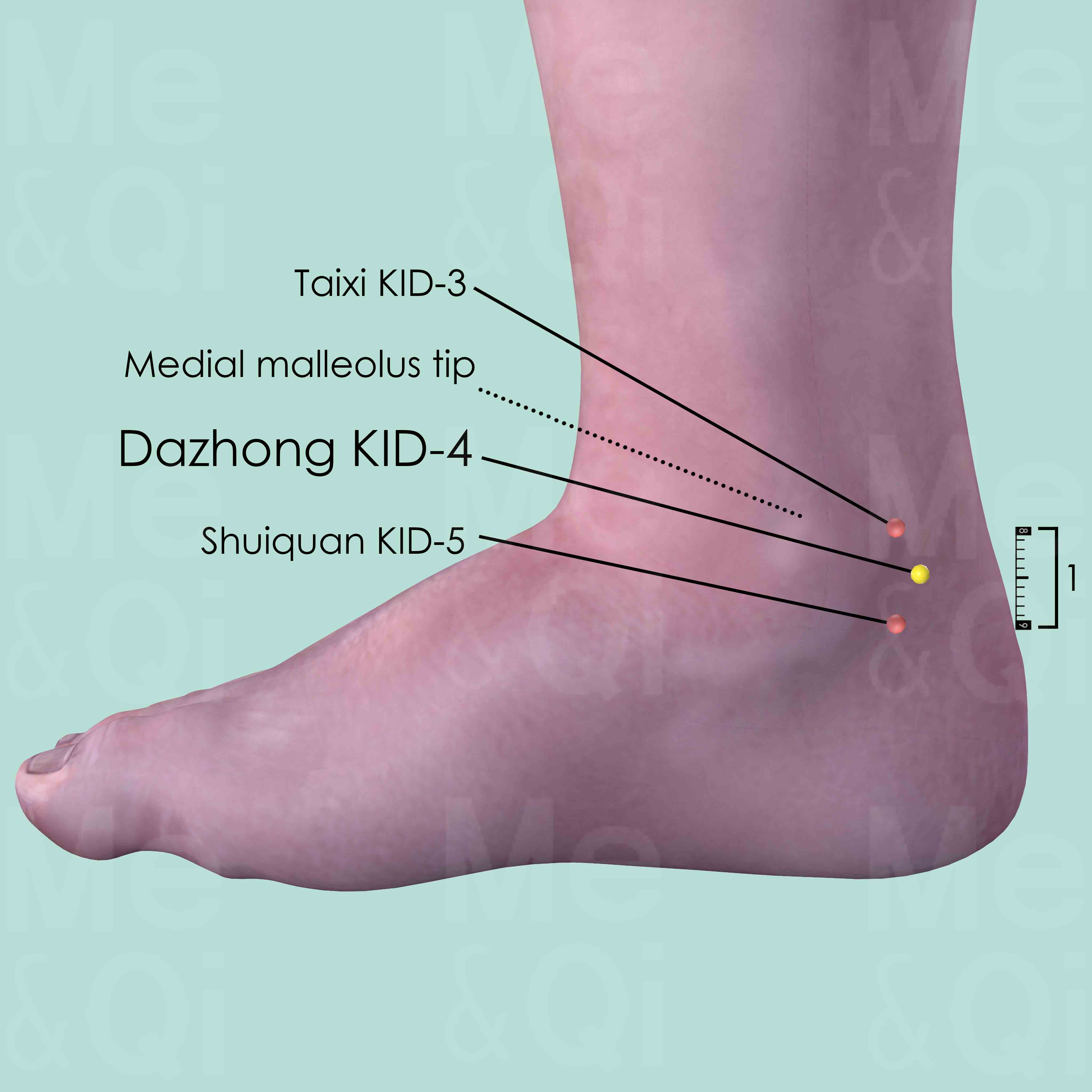
Dazhong KID-4
Posterior and inferior to the medial malleolus, in the depression medial to the Achilles tendon, superior to its insertion at the calcaneus.
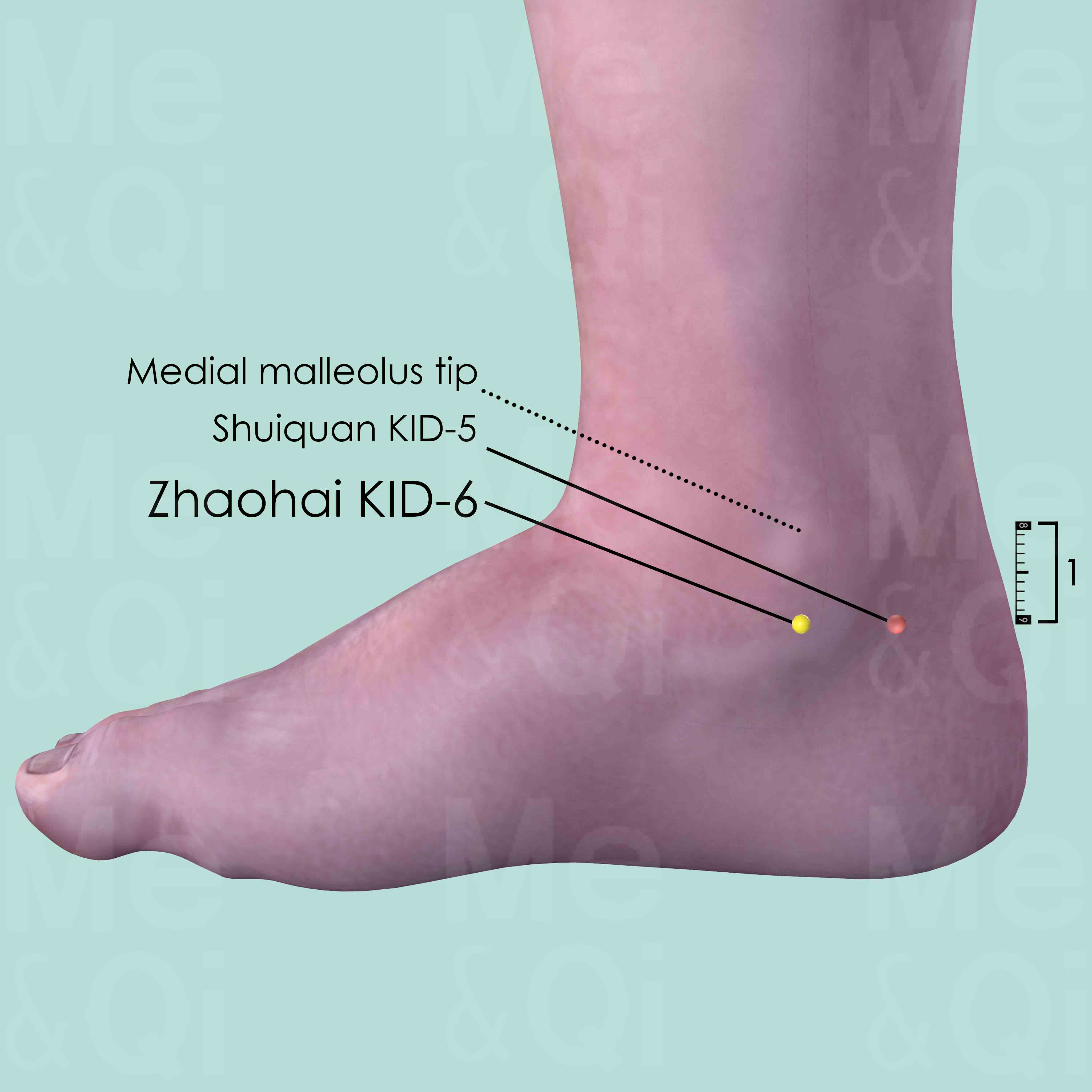
Zhaohai KID-6
Approximately 1 cun below the medial malleolus tip, over the joint space between the talus and the calcaneus.
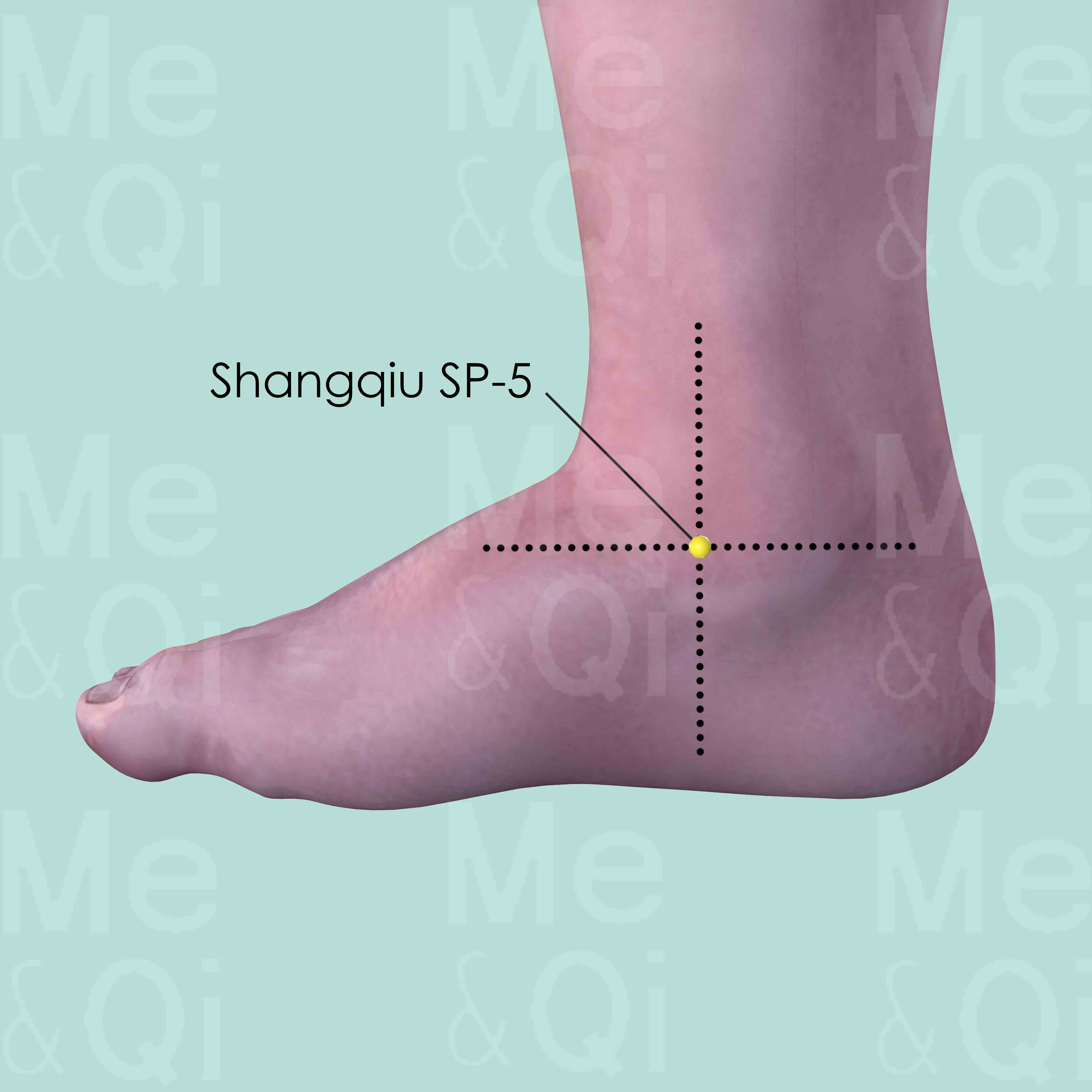
Shangqiu SP-5
In the depression distal and inferior to the medial malleolus, midway between the navicular bone tubercle and the tip of the medial malleolus.
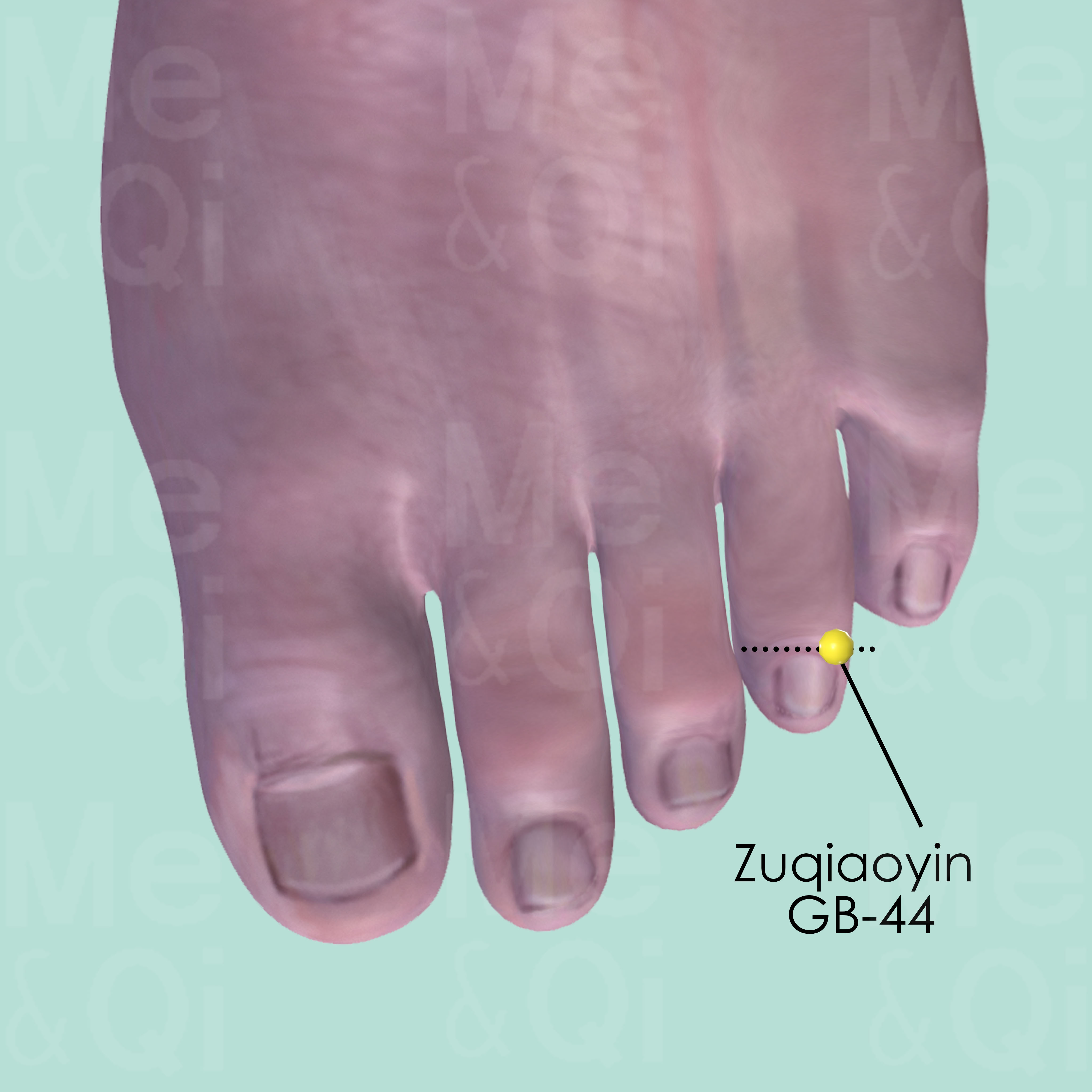
Zuqiaoyin GB-44
On the lateral side of the 4th toe, about 0.1 cun posterior to the corner of the nail.
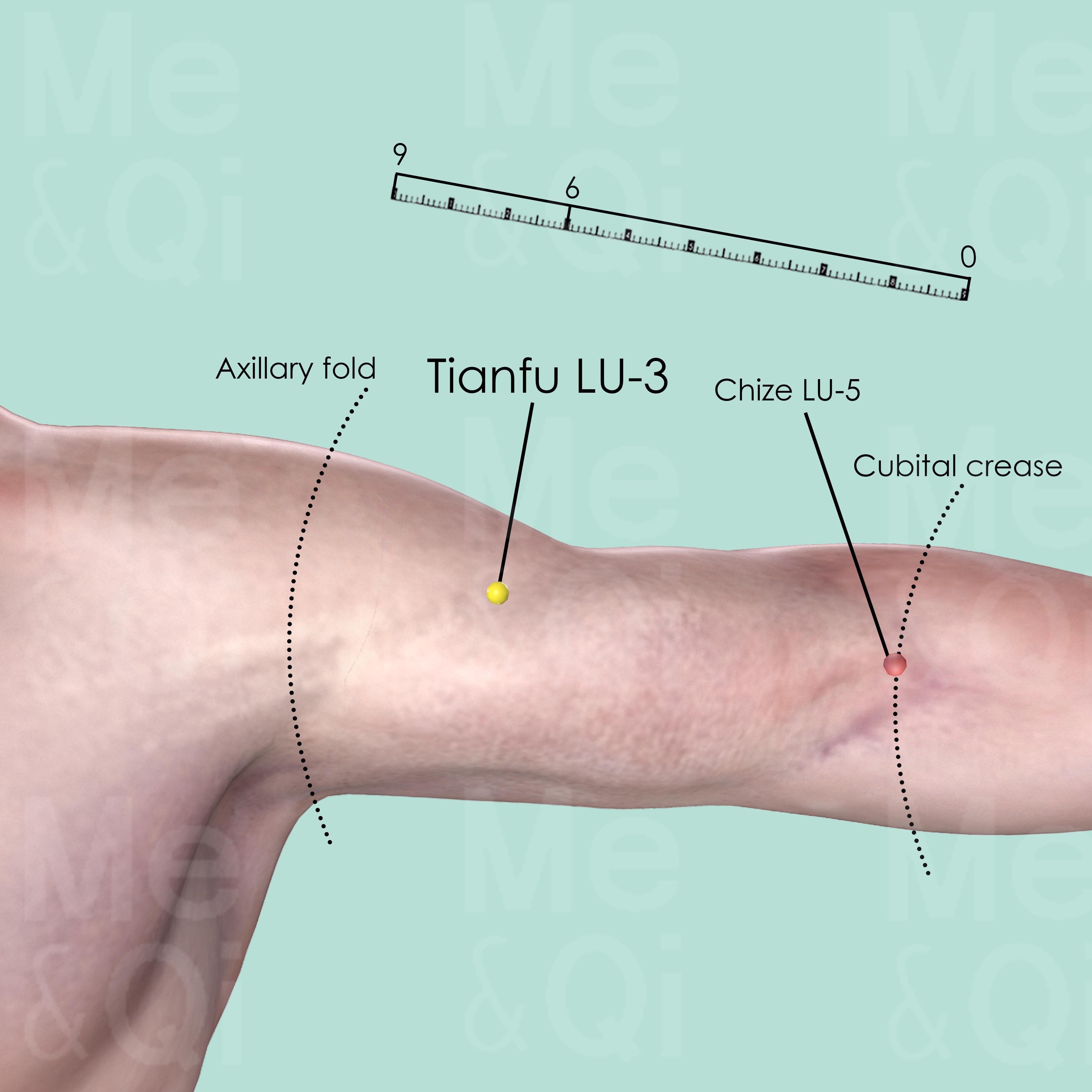
Tianfu LU-3
On the medial aspect of the upper arm, 3 cun below the end of the axillary fold and 6 cun above Chize LU-5, in the depression on the lateral border of biceps muscle.
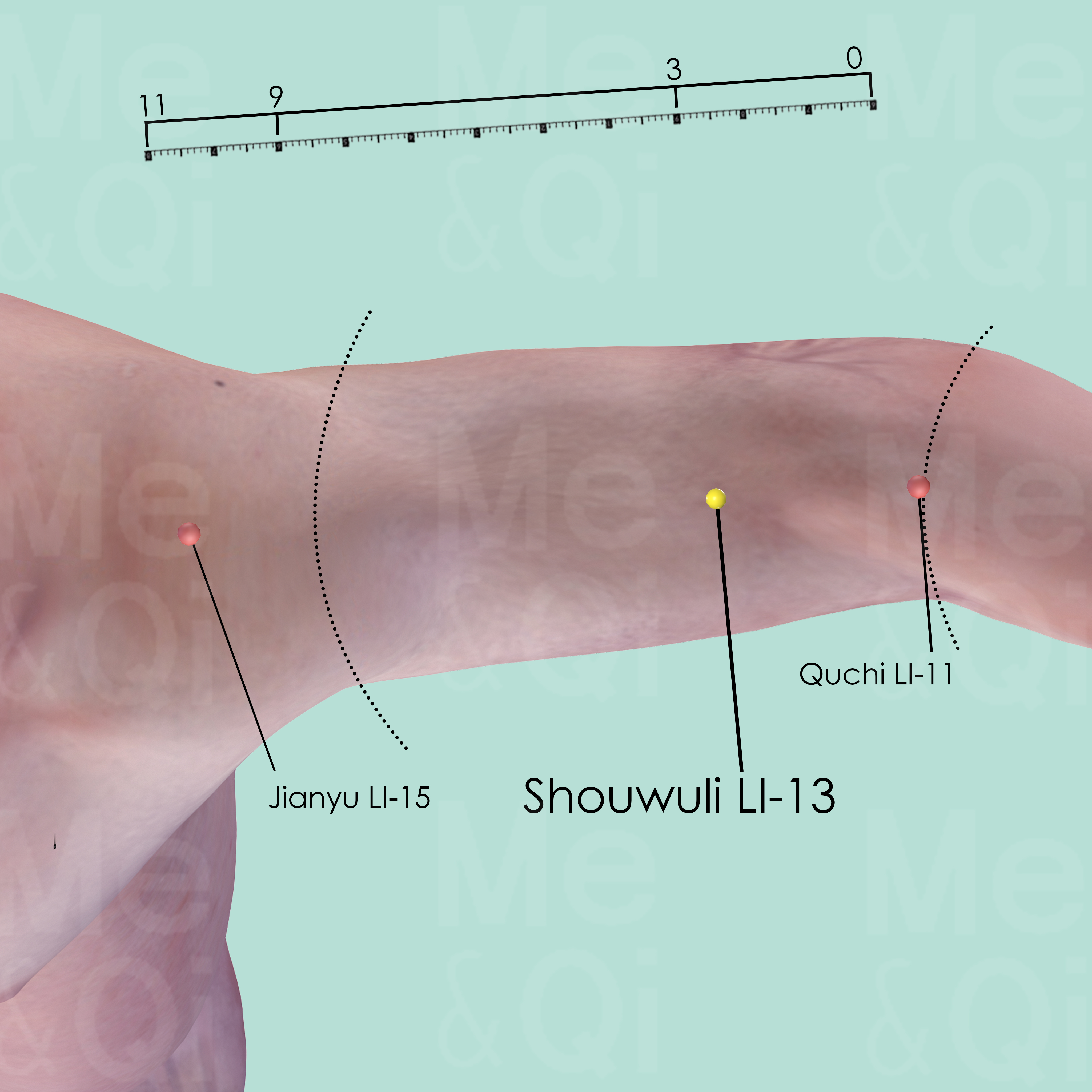
Shouwuli LI-13
Superior to the lateral epicondyle of the humerus, 3 cun above Quchi LI-11, on the line connecting Quchi LI-11 and Jianyu LI-15.

Xinhui DU-22
On the head midline, 3 cun anterior to Baihui DU-20, 2 cun posterior to the front hairline.

